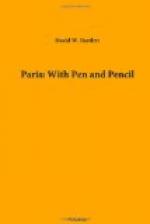Under Charles V. the city flourished finely, and the Bastille and the Palace de Tourvelles were erected. The Louvre also was repaired. Next came the unhappy reign of Charles VI., who was struck with insanity. In 1421 the English occupied Paris, but under Charles VII. they were driven from it and the Greek language was taught for the first time in the University of Paris. It had then twenty-five thousand students. Under the reign of successive monarchs Paris was, from famine and plague, so depopulated that its gates were thrown open to the malefactors of all countries. In 1470 the art of printing was introduced into the city and a post-office was established. In the reign of Francis I. the arts and literature sprang into a new life. The heavy buildings called the Louvre were demolished, and a new palace commenced upon the old site. In 1533 the Hotel de Ville was begun, and many fine buildings were erected. The wars of the sects, or rather religions, followed, and among them occurred the terrible St. Bartholomew massacre. Henry IV. brought peace to the kingdom and added greatly to the beauty and attractiveness of Paris.
Under Louis XIII. several new streets were opened, and the Palais Royal and the palace of the Luxembourg begun. Under the succeeding king the wars of the Fronde occurred, but the projects of the preceding king were carried out, and more than eighty new streets were opened. The planting of trees in the Champs Elysees, also took place under the reign of Louis XIV. The palace of the Tuileries was enlarged, the Hotel des Invalides, a foundling hospital, and several bridges were built.
Louis XV. established the manufactory of porcelain at Sevres, and also added much to the beauty of Paris. He commenced the erection of the Madeleine. Theaters and comic opera-houses were speedily built, and water was distributed over the city by the use of steam-engines.
Then broke out the revolution, and many fine monuments were destroyed. But it was under the Directory that the Museum of the Louvre was opened, and under Napoleon the capital assumed a splendor it had never known before. Under the succeeding kings it continued to increase in wealth and magnificence, until it is unquestionably the finest city in the world.
I have now in a short space given the reader a preliminary sketch of Paris, and will proceed at once to describe what I saw in it, and the impressions I received, while a resident in that city.
CHAPTER II.
RESTAURANTS—A WALK AND GOSSIP.
[Illustration: Boulevard du Temple.]
RESTAURANTS, CAFES, ETC.




